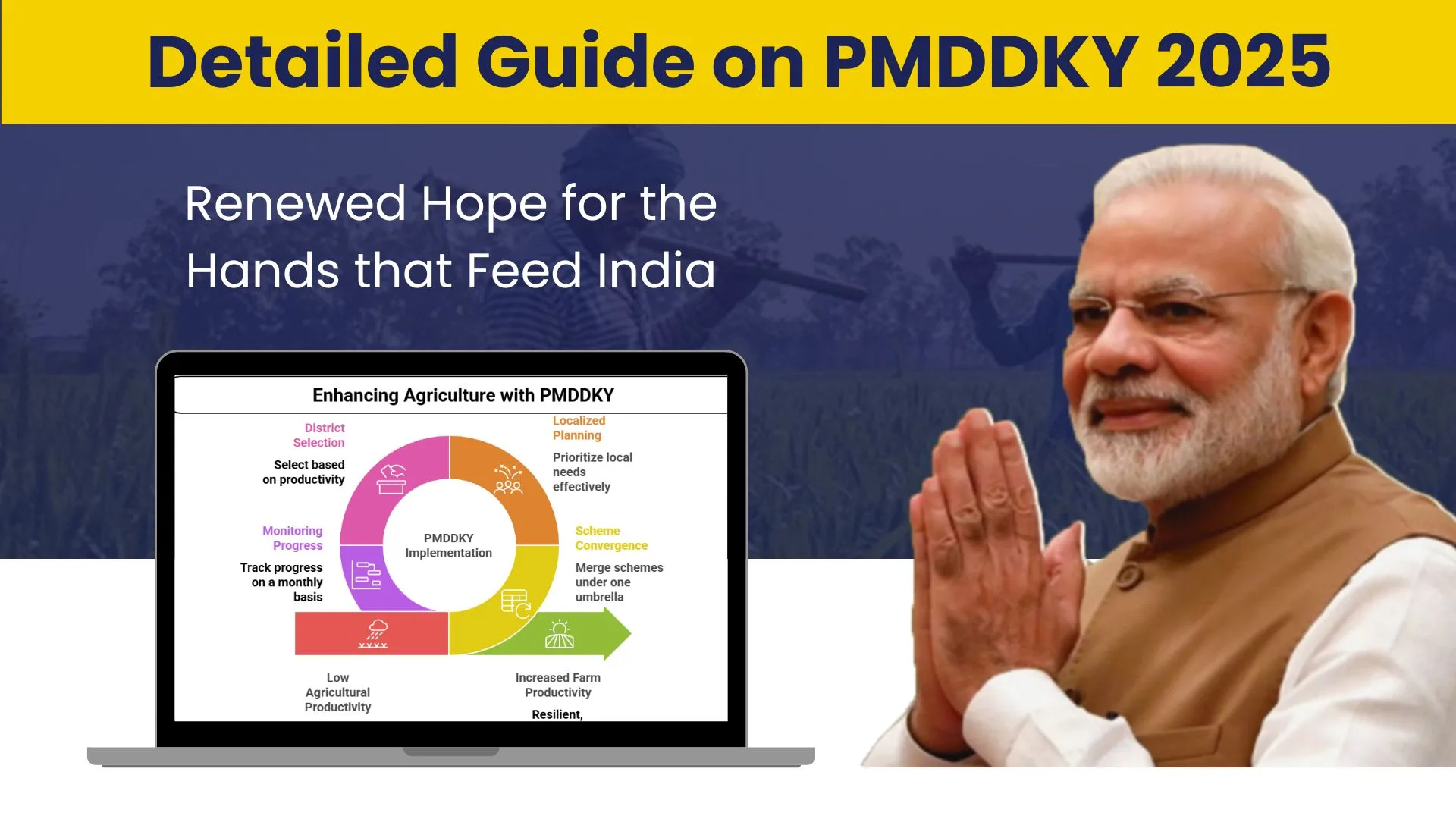
PMDDKY: Pradhan Mantri Dhan Dhaanya Krishi Yojana | PM Dhan Dhaanya Krishi Yojana
In a small village of Bundelkhand, farmer Ramkishan once watched helplessly as his crops withered under the harsh sun. With no irrigation and rising debt, he almost gave up farming—the only life he had ever known. One evening, as he sat by his dry field, his 10-year-old daughter placed a single grain of wheat in his palm and said, “Baba, next year this will grow again.”
That simple faith became his reason to try one more time. Through the PMDDKY scheme, Ramkishan received subsidized seeds, drip irrigation support, and a small loan to restart farming. The following season, his barren land turned green again. For the first time in years, he sold enough wheat to save money for his daughter’s education.
Today, Ramkishan’s story stands as a shining example of how PMDDKY is transforming rural lives — bringing hope, sustainability, and a better tomorrow to millions of farmers across India.
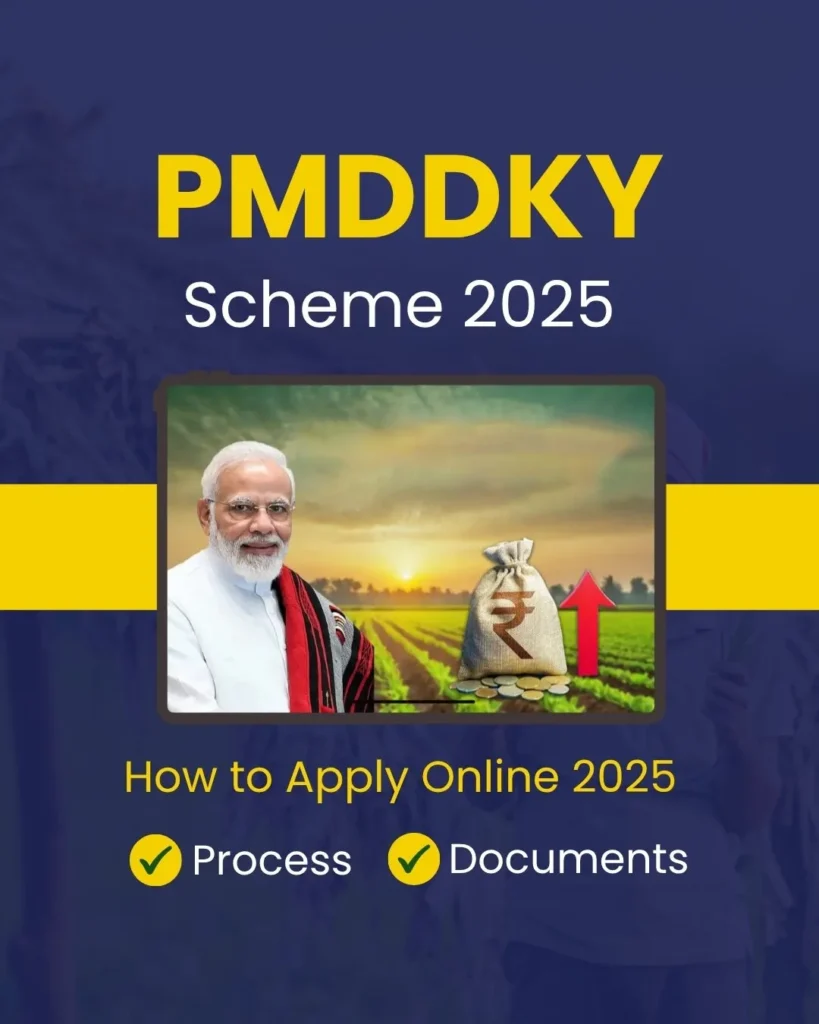
Detailed Guide on PMDDKY 2025:
The Pradhan Mantri Dhan Dhaanya Krishi Yojana is a landmark government initiative designed to transform Indian agriculture and make it more productive, sustainable, and profitable for farmers. It was announced by Finance Minister Nirmala Sitharaman on February 1, 2025, during the Union Budget 2025-26 and later approved by the Union Cabinet on July 16, 2025. This ambitious scheme focuses on 100 low-performing districts that face challenges such as poor crop yields, scarcity, and lack of access to modern farming resources. With an annual budget of ₹24,000 crore for six years from 2025-26 to 2030-31, totaling ₹1.44 lakh crore, Scheme aims to uplift around 1.7 crore farmers, especially small and marginal farmers owning less than 2 hectares of land. These farmers represent 86 percent of India’s farming population, as reported in the Economic Survey 2024-25.
The PM Dhan Dhaanya Krishi Yojana brings together 36 existing agricultural schemes from 11 different ministries into one unified program. It merges popular schemes like PM-KISAN for income support, PMFBY for crop insurance, PMKSY for irrigation, and Rashtriya Krishi Vikas Yojana (RKVY) for agricultural development. This integration helps eliminate overlapping efforts, ensures better coordination, and improves efficiency. Inspired by the success of NITI Aayog’s Aspirational Districts Programme, This scheme targets regions with low crop productivity (such as wheat yields below 3.5 tonnes per hectare), limited crop intensity (below 155 percent or less than 1.55 crop cycles per year), and restricted access to agricultural credit. By providing modern irrigation, storage facilities, farmer training, access to technology, and affordable credit, the scheme aims to increase farmer income, strengthen food security, and promote the vision of Atmanirbhar Bharat, or a self-reliant India. According to Union Agriculture Minister Shivraj Singh Chouhan, the program is a major step toward achieving a poverty-free India through sustainable agriculture and rural empowerment.
The implementation of this scheme will be managed by the Ministry of Agriculture and Farmers’ Welfare. It will be monitored by a National Steering Committee, State Nodal Committees, and District Dhan Dhaanya Samitis headed by District Collectors. These authorities will tailor the scheme according to local needs and monitor its performance through a digital dashboard featuring 117 Key Performance Indicators (KPIs) such as crop yields, irrigation coverage, loan distribution, and warehouse utilization. The Pradhan Mantri Dhan Dhaanya Krishi Yojana is expected to launch in October 2025 for the Rabi season, with online applications opening in September 2025.
What is PMDDKY?
The Pradhan Mantri Dhan Dhaanya Krishi Yojana is a newly launched government scheme aimed at empowering farmers across India. Through this initiative, farmers will receive direct financial assistance, modern agricultural tools, crop insurance coverage, and improved access to markets. Announced during the Union Budget 2025, the scheme’s main goal is to make farming simpler, more advanced, and more profitable for every farmer in the country.
Why PMDDKY Was Launched?
Indian agriculture, employing around 46% of the nation’s workforce (Economic Survey 2024-25), continues to face major challenges that limit its ability to ensure sustainable livelihoods and maintain national food security.
- Low Crop Productivity: Several regions, especially in Uttar Pradesh (Purvanchal, Bundelkhand), Bihar (Seemanchal), and tribal areas of Madhya Pradesh, experience poor agricultural yields due to degraded soil quality, traditional farming practices, and limited irrigation facilities. For example, the average rice yield in Seemanchal is just 1.8 tonnes per hectare, significantly lower than the national average of 2.7 tonnes per hectare.
- Dependence on Monsoons: Nearly 52% of India’s agricultural land still depends on unpredictable monsoon rains, making farmers highly vulnerable to droughts and irregular rainfall. For instance, during the 2023 drought in Bundelkhand, around 30% of crops were damaged, highlighting the risks of rain-dependent farming.
- Small Landholdings: Approximately 86% of farmers own less than 2 hectares, earning an average of ₹10,218 per month (NSSO 2019), which is often insufficient to meet family needs, leading to debt and distress.
- Lack of Modern Resources: A large number of farmers are unable to access or afford high-quality seeds, bio-fertilizers, and modern machinery such as tractors and harvesters, which restricts their productivity and overall efficiency.
- Post-Harvest Losses: Around 20% of crops, including tomatoes and mangoes, are lost each year because of insufficient storage and processing facilities, leading to an estimated annual loss of ₹50,000 crore, according to ICAR (2023).
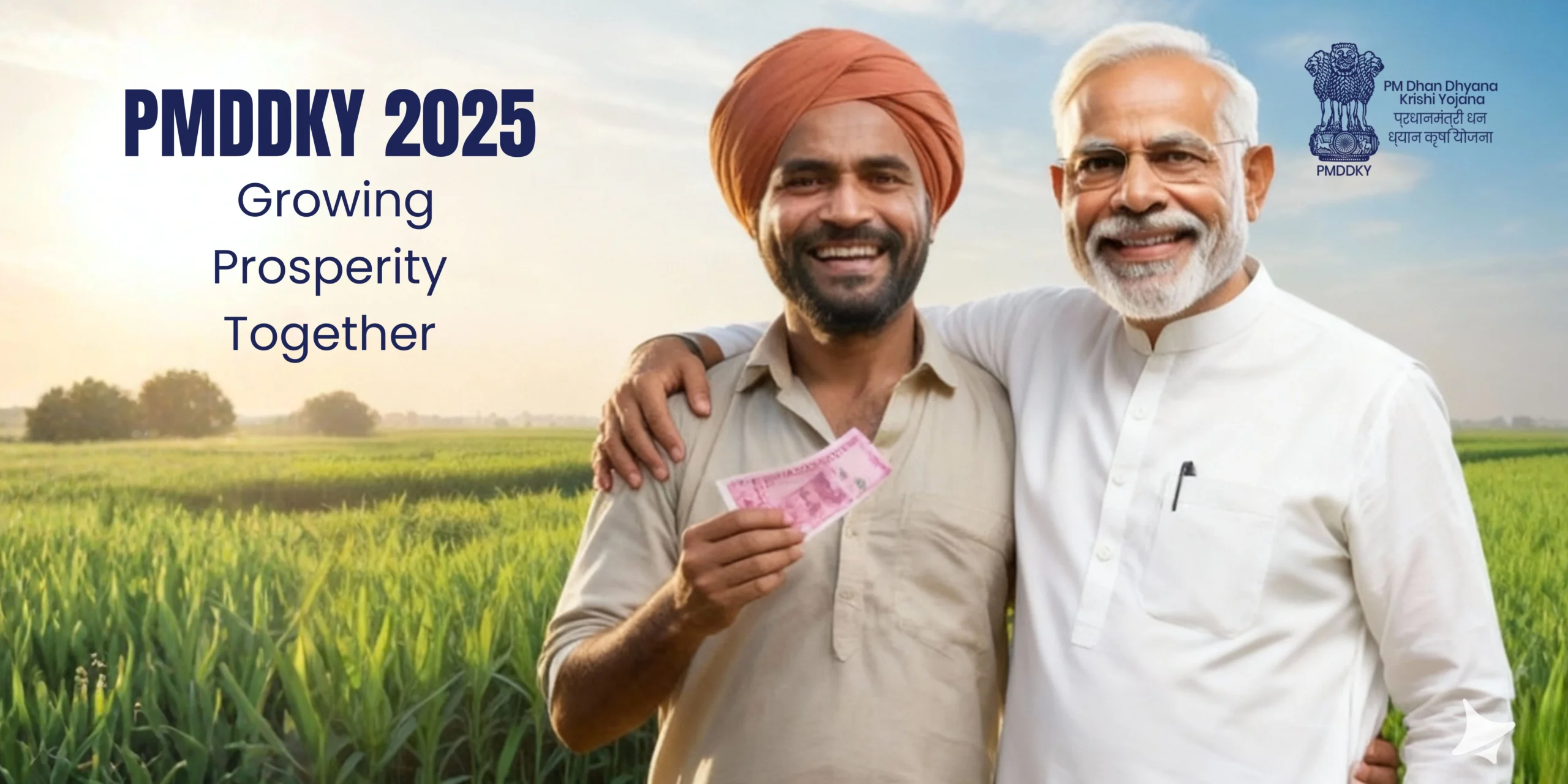
Objectives:
- Boost crop yields by 20–30% using better seeds and modern technology.
- Cut dependence on monsoons through drip and sprinkler irrigation.
- Provide affordable farm tools to improve efficiency and output.
- Develop storage facilities to reduce post-harvest losses to below 5%.
- Expand credit and market access to help double farmer income by 2030.
- Encourage organic and sustainable farming to protect soil and water.
- Empower women, youth, and allied sectors like dairy, fisheries, and poultry.
- Strengthen self-reliance in foodgrains, pulses, and oilseeds to cut imports.
Key Benefits of PMDDKY
provides a wide range of benefits aimed at transforming India’s agricultural sector:
1. Higher Crop Yields
Access to hybrid seeds, bio-fertilizers, and mechanized tools to increase production.
2. Increased Income
Grow high-value crops like pulses and vegetables with direct market access to raise profits by 20–40%.
3. Sustainable Farming:
Promote organic inputs, water-efficient irrigation, and climate-resilient crops.
4. Advanced Irrigation:
Drip and sprinkler systems to enable year-round farming in dry areas.
5. Storage Solutions:
Village and block-level warehouses and cold storage to reduce post-harvest losses.
6. Financial Support:
Subsidies on inputs and short- or long-term loans via Kisan Credit Cards or NABARD.
7. Market Connectivity:
Digital platforms like e-NAM and apps to sell directly to buyers.
8. Training & Skills:
Free workshops on modern farming, drones, and allied activities like beekeeping.
9. Women Empowerment:
Support for women producer groups with training, loans, and market linkages.
10. Global Exposure:
Fully funded international training for farmers in precision farming, drip irrigation, and greenhouse technology.
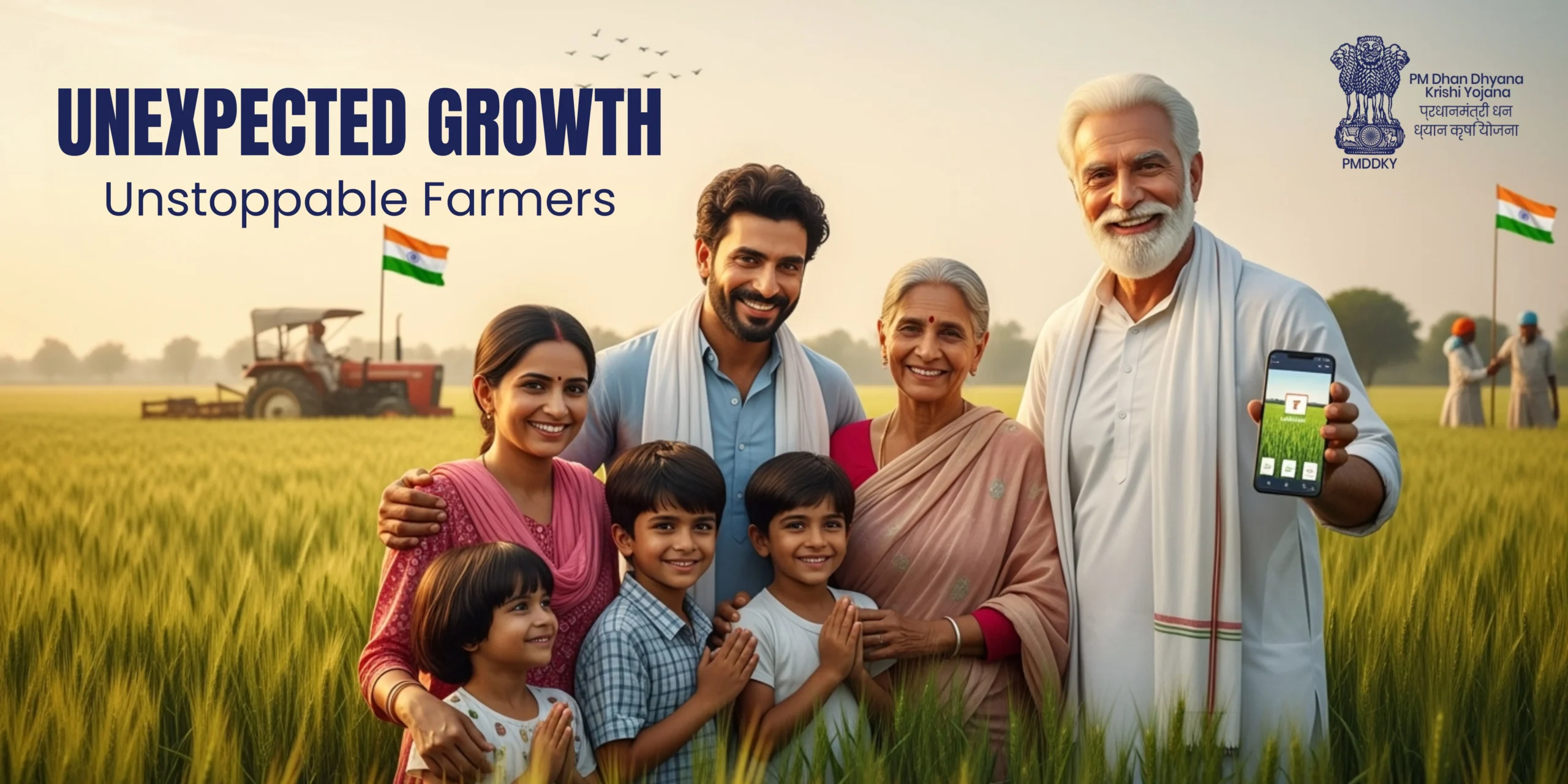
PMDDKY Benefits
| Benefit | Description | Impact |
|---|---|---|
| Crop Yields | High-yielding seeds, tools | 20-30% more output |
| Income | Diversified crops, direct sales | 20-40% profit increase |
| Sustainability | Organic farming, water-saving systems | Healthier soil, eco-friendly |
| Irrigation | Drip/sprinkler systems | Saves 30-50% water |
| Storage | Warehouses, cold storage | Saves 20% of crops |
| Financial Aid | Subsidies, loans | Affordable inputs, investment |
| Market Access | e-NAM, PMDDKY apps | Higher prices, no middlemen |
| Training | Workshops, global programs | Modern skills, global exposure |
These initiatives are designed to make farming more efficient, profitable, and resilient, benefiting 1.7 crore farmers over a six-year period.
Who Can Apply for PMDDKY scheme?
structured to assist farmers and agricultural workers across the 100 targeted districts.
- Small and Marginal Farmers: Those owning less than 2 hectares, forming 86% of India’s farmers, supported under the scheme for better yields and resources.
- Women Farmers: Women in farming or allied sectors like dairy, poultry, beekeeping, and organic vegetables, especially in registered producer groups.
- Young Farmers: Youth adopting modern techniques or starting agribusinesses such as organic farming or value-added products.
- Farmers in Low-Productivity Areas: Those in districts with low yields, low cropping intensity, or limited access to credit, targeted by the scheme.
- Farmer Producer Organizations (FPOs): Groups benefiting from shared resources like bulk loans, storage, and market linkages.
- Allied Sector Workers: Individuals in dairy, fisheries, poultry, or apiculture contributing to diversified rural incomes.
Large farmers and private companies can take part in the scheme through public-private partnerships (PPPs) to develop infrastructure such as storage facilities, processing units, and technology dissemination. Eligibility criteria will be finalized by District Dhan Dhaanya Samitis once the district list is released on July 31, 2025. To qualify, farmers must reside or operate within the selected districts, and a verification process will ensure that benefits reach authentic beneficiaries.
How to Apply for PMDDKY?
As of July 25, 2025, the scheme application process is still being finalized. However, based on procedures from similar programs like PM-KISAN and PMFBY, the likely steps are as follows:
- Check District Inclusion: Confirm if your area is among the 100 selected districts via KVK, District Collector, or Gram Panchayat.
- Contact District Samiti: Reach out to the District Dhan Dhaanya Samiti for guidance and application support.
- Register Details: Provide personal and farm information including Aadhaar, land size, crops, and allied activities.
- Submit Documents: Upload or submit proof of eligibility and farming status.
- Select Benefits: Choose support such as seeds, irrigation, loans, storage, or training.
- Verification: The Samiti will verify information through documents, field visits, or digital checks.
- Receive Support: Approved farmers get subsidies, loans, storage access, and training within 2–4 weeks.
Applications for the scheme are expected to open in September 2025, ahead of the October 2025 Rabi season, which includes crops like wheat and pulses. Farmers are advised to check official websites such as www.pmkisan.gov.in and www.agricoop.nic.in, or contact their local Krishi Vigyan Kendra (KVK) for the latest updates on the application process and deadlines.
Documents Required for PMDDKY
Based on the requirements of similar programs like PM-KISAN and PMFBY, the following documents are expected to be required:
- Aadhaar Card: For identity verification and linking benefits.
- Land Papers: Records, patta, or lease to prove land ownership.
- Bank Details: Passbook or statement for subsidies and loans.
- Farmer ID: Kisan Credit Card, PM-KISAN ID, or similar for verification.
- Address Proof: Ration card, voter ID, or utility bill.
- Photographs: Recent passport-size photos for registration.
- Women Group Certificate: For women in registered producer groups.
- FPO Certificate: For farmer groups claiming collective benefits.
- Caste Certificate: For SC/ST applicants to access reserved benefits.
- Soil Health Card: Optional, for tailored inputs like fertilizers or seeds.
Farmers should keep both original and photocopies of these documents ready and consult their local District Dhan Dhaanya Samiti for any additional or district-specific requirements once the application process is officially announced.
Online and Offline Application for PMDDKY
The PMDDKY scheme provides easy access with flexible application options:
- Online Application:
- Government Portal or Mobile App: A dedicated platform, possibly an extension of Kisan Suvidha or a new PMDDKY app, will be launched by October 2025.
- Application Steps: Farmers can visit the portal or app, enter Aadhaar and farm details (land size, crops), upload documents, select desired benefits, and submit their application.
- Common Service Centers (CSCs): Rural kiosks will assist farmers without internet or smartphones, providing support for a small fee of ₹50–100.
- Digital Literacy Support: Campaigns run by KVKs and local NGOs will guide farmers in navigating the online application process.
- Offline Application:
- In-Person Application: Farmers can apply at the District Dhan Dhaanya Samiti, KVK, or Gram Panchayat office.
- Application Process: Collect a physical form, fill in details such as name and crops, attach documents, submit to officials, and obtain a receipt for tracking.
- Assistance: Agricultural officers, village workers, and Samiti staff will guide applicants, especially in areas with limited internet access.
The government will share details about the portal, mobile app, and office locations closer to the launch. Awareness campaigns via radio, SMS, WhatsApp, and KVKs will inform farmers in rural and remote areas about the application process, aiming to reach 90% of eligible farmers in the 100 selected districts by September 2025.
Financial and Material Support Available
The scheme offers a comprehensive package of financial and material support designed to meet the specific needs of farmers.
- Subsidies: 50–80% off on high-yield seeds, bio-fertilizers, and equipment like drip irrigation systems.
- Short-Term Loans: ₹50,000–₹1 lakh at 4–7% interest via Kisan Credit Cards for inputs like seeds and fertilizers.
- Long-Term Loans: ₹1–10 lakh for tractors, harvesters, or storage units through NABARD or banks.
- Storage Access: Free or low-cost warehouses and cold storage to reduce post-harvest losses.
- Irrigation Support: Subsidized drip and sprinkler systems saving 30–50% water and enabling year-round farming.
- Training Programs: Free workshops on organic farming, mechanization, and allied activities like poultry or beekeeping.
- Market Support: Access to digital platforms like e-NAM and PMDDKY apps for direct sales, boosting profits by 20–30%.
- Global Exposure: Fully funded international training for 500 farmers in advanced techniques like precision farming, drip irrigation, and greenhouse technology.
The ₹24,000 crore annual PMDDKY budget is divided as 40% for subsidies, 30% for infrastructure, 20% for loans, and 10% for training and market access, ensuring support tailored to each district’s agricultural needs.
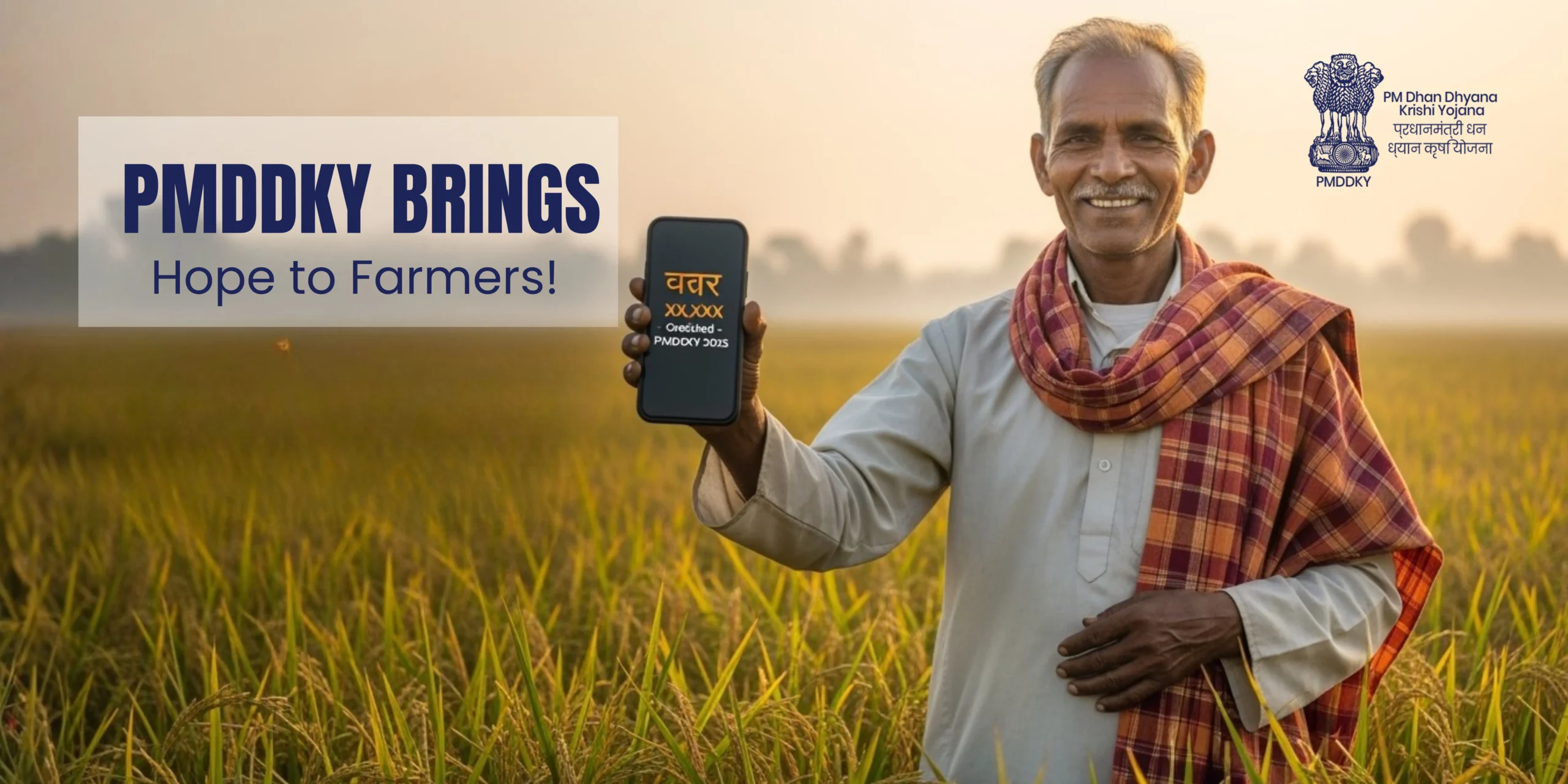
| Support Type | Description | Cost to Farmer | Cost to Farmer |
|---|---|---|---|
| Subsidies | Seeds, fertilizers, drip systems | 20-50% of cost | Reduces input costs by 50% |
| Short-Term Loans | ₹50,000–₹1 lakh, 4-7% interest | Repayable in 1-2 years | Enables sowing, pest control |
| Long-Term Loans | ₹1–10 lakh | Repayable in 5-10 years | Supports mechanization, infrastructure |
| Storage Access | Warehouses, cold storage | Free or ₹100-500/month | Saves 20% of crops |
| Irrigation | Drip/sprinkler systems | ₹3,000–₹10,000/hectare | Year-round farming, water savings |
Which States Will Benefit PMDDKY?
NITI Aayog will finalize the list of 100 districts by July 31, 2025, considering the following factors:
- Low Crop Productivity: Districts with yields below national averages, such as wheat under 3.5 tonnes/hectare or rice under 2.7 tonnes/hectare.
- Moderate Cropping Intensity: Areas with fewer than 1.55 crop cycles per year compared to the national average of 155%.
- Limited Credit Access: Regions where less than 30% of farmers have access to bank loans or Kisan Credit Cards.
- Geographic Coverage: Ensuring at least one district from each state and Union Territory is included for nationwide representation.
Which Districts Will Benefit?
Which Districts Will Benefit?
Likely Priority Districts:
- Uttar Pradesh: Purvanchal (Gorakhpur, Varanasi, Azamgarh) and Bundelkhand (Jhansi, Banda, Chitrakoot), known for low yields and water scarcity.
- Bihar: Seemanchal (Purnea, Katihar, Araria) with poor irrigation and credit access.
- Madhya Pradesh: All Tribal districts like Jhabua, Barwani, and Alirajpur with low productivity.
- Rajasthan: Arid districts like Barmer, Jaisalmer, and Bikaner facing severe water challenges.
- Northeast: Dhubri (Assam), Mon (Nagaland), and West Khasi Hills (Meghalaya) with underdeveloped infrastructure.
- Other States: Backward districts in Odisha (Kalahandi), Jharkhand (Dumka), Chhattisgarh (Bastar), and Andhra Pradesh (Anantapur).
The final list of selected districts will be available on government portals such as www.agricoop.nic.in and www.niti.gov.in. Farmers can confirm their inclusion by contacting the District Collector, KVK, or Gram Panchayat after July 31, 2025. The selection process is based on NITI Aayog’s data analysis, consultations with state governments, and alignment with national agricultural priorities to ensure the most deserving regions are targeted.
Support for Small and Marginal Farmers
Small and marginal farmers, representing 86% of India’s agricultural population, are the main beneficiaries of the PMDDKY scheme.
- Subsidized Inputs: Reduced costs for seeds, bio-fertilizers, and small tools.
- Easy Loans: Short-term loans of ₹50,000–₹1 lakh at 4–7% interest for farming needs.
- Irrigation Support: Affordable drip systems enabling multiple crops in dry seasons.
- Storage Access: Low-cost or free village warehouses and cold storage to prevent post-harvest losses.
- Training Programs: Free KVK workshops on organic farming, crop rotation, and mechanization.
- Market Linkages: Digital platforms like e-NAM help farmers get 20–40% higher prices.
- Crop Diversification: Assistance to grow high-value crops like pulses and vegetables.
Special Support for Women Farmers
The scheme emphasizes women’s empowerment as a key strategy to strengthen rural communities (PMDDKY).
- Women Producer Groups: Support for 10,000 groups through training, loans, and market access in dairy, poultry, beekeeping, and organic farming. By July 2025, 5,000 groups are registered, with another 5,000 planned by December 2025, potentially benefiting 5 lakh women.
- Training Programs: Free workshops on modern farming, value-added products like cheese or jams, and business skills for starting or expanding enterprises.
- Microfinance Loans: Low-interest loans of ₹10,000–₹1 lakh for inputs or ventures such as honey or poultry farming.
- Direct Market Access: Digital platforms and cooperatives help women sell products directly, earning 20–50% higher prices.
- Leadership Roles: Women participate in District Dhan Dhaanya Samitis to shape local agricultural planning and promote gender-inclusive policies.
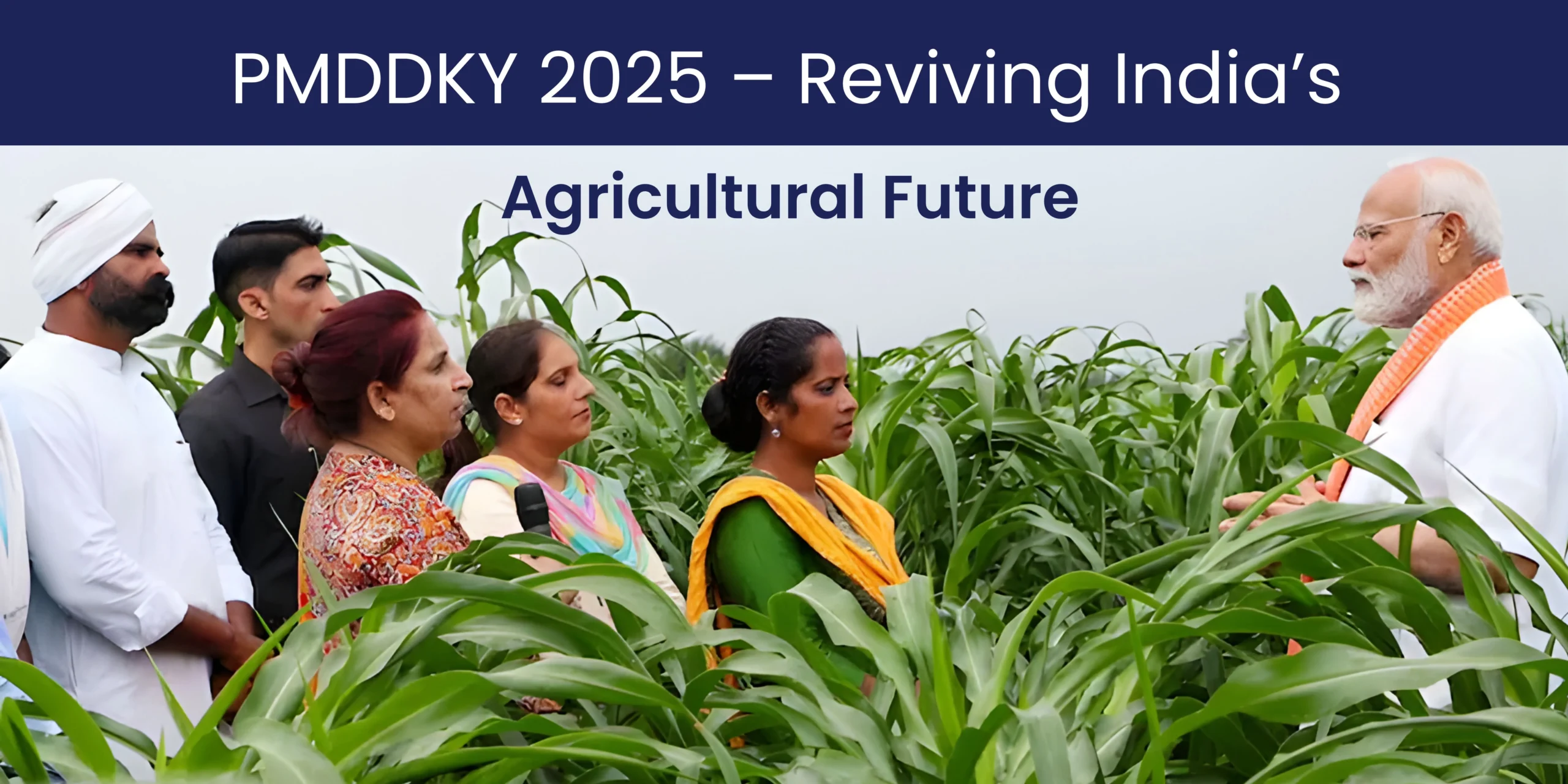
| Support Type | Description | Cost to Farmer | Impact |
|---|---|---|---|
| Subsidies | Seeds, fertilizers, drip systems | 20-50% of cost | Reduces input costs by 50% |
| Short-Term Loans | ₹50,000–₹1 lakh, 4-7% interest | Repayable in 1-2 years | Enables sowing, pest control |
| Long-Term Loans | ₹1–10 lakh | Repayable in 5-10 years | Supports mechanization, infrastructure |
| Storage Access | Warehouses, cold storage | Free or ₹100-500/month | Saves 20% of crops |
| Irrigation | Drip/sprinkler systems | ₹3,000–₹10,000/hectare | Year-round farming, water savings |
| Support Type | Description | Impact |
|---|---|---|
| Producer Groups | Training, loans for 10,000 groups | Empowers 5 lakh women |
| Microfinance | ₹10,000–₹1 lakh loans | Starts small businesses |
| Market Access | Apps, cooperatives for direct sales | 20-50% higher profits |
| Training | Farming, value addition skills | Increases income, leadership |
Support for Women Farmers
This support enables women to earn independently, support their households, and take active roles in community development.
Benefits for Large Farmers and Private Companies
Although this scheme primarily targets small farmers, large farmers and private companies can also benefit through:
- Public-Private Partnerships (PPPs): Collaborate with companies like ITC, Mahindra, or Godrej to provide seeds, machinery, and market platforms, sharing infrastructure costs.
- Storage Access: Utilize new warehouses and cold storage for bulk crops such as grains, pulses, and fruits.
- Long-Term Loans: Funding of ₹1–10 lakh for large projects like greenhouses, processing units, or mechanized farms.
- Advanced Technology: Use of drones, IoT sensors, and precision farming tools to boost efficiency and reduce labor.
- Export Opportunities: Partner selling high-value crops like organic spices and fruits in domestic and international markets, increasing profits.
Irrigation Improvements
PMDDKY tackles water scarcity, crucial for the 52% of Indian farmland dependent on monsoons:
- Drip and Sprinkler Systems: Deliver water directly to roots, saving 30–50% water and increasing yields by up to 20%.
- Expanded Coverage: Focuses on rain-dependent districts like Bundelkhand and Seemanchal for year-round farming.
- Subsidies: Covers 50–80% of irrigation costs (₹15,000–₹50,000 per hectare).
- Smart Irrigation: IoT soil sensors optimize water use, improving efficiency.
Storage and Warehousing
Reduces post-harvest losses of up to 20% in perishables like fruits, vegetables, and dairy:
- Village & Block Warehouses: Store grains, pulses, and vegetables within 5–10 km of farms.
- Cold Storage Units: Preserve quality of perishables like milk, tomatoes, and mangoes.
- Affordable Access: Subsidized rates for small farmers (₹100–500/month).
- Processing Units: Produce value-added goods like tomato puree or packaged milk, boosting profits 30–50%.
Crop Insurance Coverage
Integrated with PMFBY to safeguard farmers:
- Coverage: Protects crops from natural disasters, pests, and diseases.
- Low Premiums: 1.5% for kharif, 2% for rabi, 5% for horticulture; government subsidizes the rest.
- Easy Claims: Apply via local offices or apps; payouts processed quickly using satellite data.
- Full Protection: Covers pre-sowing and post-harvest losses.
Easy Access to Loans
Financial support for farm investments:
- Short-Term Loans: ₹50,000–₹1 lakh at 4–7% interest for seeds, fertilizers, or pesticides.
- Long-Term Loans: ₹1–10 lakh for tractors, harvesters, or storage, with 5–10 year repayment.
- Credit Assessment: Grameen Credit Score simplifies approvals for farmers without collateral.
- Microfinance for Women: ₹10,000–₹1 lakh for ventures like poultry or beekeeping.
- Fast Processing: Loans approved within 7–14 days.
Market Access and Crop Sales
Maximizes farmer profits through better market linkages:
- Digital Platforms: e-NAM and PMDDKY apps connect farmers directly to buyers, earning 20–40% higher prices.
- Private Partnerships: Facilitate sales to urban and export markets for high-value crops.
- Local Infrastructure: Warehouses and processing units help sell locally at competitive rates.
- FPO Support: Groups negotiate bulk sales, increasing profits by 20–30%.
Support for Organic and Smart Farming
Promotes sustainable, tech-driven agriculture:
- Organic Farming: Subsidized bio-fertilizers, organic certification, and training on chemical-free techniques.
- Smart Farming: Drones, IoT sensors, and mobile apps optimize inputs, reduce labor costs, and improve yields.
Training and Mechanization
Equips farmers with modern skills and tools:
- Training Programs: Free workshops on organic farming, mechanization, and allied sectors like poultry or beekeeping.
- Global Exposure: 500 farmers receive international training in precision farming, drip irrigation, and greenhouse technology.
- Mechanization: Subsidized tractors, harvesters, seed drills, and drones improve efficiency and reduce labor.
Opportunities for Young Farmers
Encourages youth to pursue agriculture:
- Skill Development: Training in smart farming, agribusiness, and allied sectors.
- Technology Access: Use of drones, sensors, and apps for efficient farming.
- Financial Support: Subsidies and loans (₹50,000–₹5 lakh) to start ventures like organic farms or poultry.
- Job Creation & Entrepreneurship: Work in dairy, fisheries, or processing units; launch agribusinesses with market support.
- Global Exposure: International training brings innovative techniques to India.
Result: scheme modernizes agriculture, increases productivity, and makes farming a profitable and attractive career, especially for young people.
Latest News and Updates
Key Updates as of July 25, 2025
- Cabinet Approval: PMDDKY was approved on July 16, 2025, with an annual budget of ₹24,000 crore for 2025-26 to 2030-31.
- District Selection: NITI Aayog will finalize 100 districts by July 31, 2025, focusing on low-productivity and low-credit areas like Purvanchal, Bundelkhand, and Seemanchal.
- Uttar Pradesh Integration: Aligns with UP-AGREES, targeting 28 districts with ₹5,000 crore annually for irrigation, storage, and yield improvements.
- Women Producer Groups: 5,000 groups registered, with another 5,000 planned by December 2025, supporting women in dairy, poultry, and organic farming.
- Digital Dashboard: Beta version tracks 117 KPIs such as crop yields, loan disbursals, storage use, and women’s participation.
- Launch Timeline: PMDDKY will start in October 2025 for the Rabi season (wheat, pulses).
- Stay Updated: Farmers can check www.pmkisan.gov.in, www.agricoop.nic.in, or contact KVKs, District Collectors, or Gram Panchayats.
Launch in Your Area
- Nationwide launch is October 2025 with the Rabi crop season.
- Exact start depends on District Agriculture and Allied Activities Plan prepared by local Samitis.
- After district announcements on July 31, 2025, farmers should contact District Collectors, KVKs, or Gram Panchayats for local timelines.
- Districts with existing infrastructure may start earlier; remote areas require extra setup for storage and irrigation.
Farmer Registration
- Status: Registration hasn’t started as of July 25, 2025; expected to begin September 2025.
- Target: 1.7 crore farmers over six years (~28 lakh per year).
- First-Year Goal: 10–15% of eligible farmers in 2025-26, scaling to full coverage by 2030.
- State Estimates: 5–7 lakh farmers in larger states like UP and Bihar; smaller numbers in Nagaland and Sikkim.
- Check Updates: Through local Samitis, KVKs, or government portals.
Budget Details
- Annual Budget: ₹24,000 crore (₹1.44 lakh crore over six years).
- Funding Source: Convergence of 36 schemes across 11 ministries (PM-KISAN, PMFBY, PMKSY).
- Allocation: 40% for subsidies, 30% for infrastructure, 20% for loans, 10% for training and market support.
- Agriculture Budget 2025-26: ₹1.37 lakh crore (4% increase from 2024-25), with PMDDKY as a flagship program.
Farmer Feedback
- Positive Sentiments: Excitement about irrigation, storage, and technology; small farmers in UP and Bihar welcome focus on low-yield areas.
- Concerns: Uncertainty about application procedures and convergence of 36 schemes.
- Youth Engagement: Young farmers value smart farming tools and global training opportunities.
- Government Response: Awareness campaigns via radio, SMS, WhatsApp, apps, and KVKs to reach 90% of eligible farmers by September 2025, including local workshops and multilingual guides.
PMDDKY faces key challenges with planned solutions:
Coordination: Integrating 36 schemes across 11 ministries may cause delays.
Solution: Appoint Central Nodal Officers for smooth operations.
Awareness: Remote or low-literacy farmers may miss application info.
Solution: Radio, SMS, WhatsApp campaigns, village workshops, and local-language guides.
Weather Risks: Droughts, floods, or unseasonal rains can reduce yields.
Solution: Drought-resistant seeds, smart irrigation, and PMFBY insurance.
Equitable Distribution: Infrastructure gaps may cause uneven benefits.
Solution: Monitor 117 KPIs via digital dashboard with audits.
Infrastructure Deficits: Lack of roads, electricity, or internet limits storage and tech use.
Solution: PPPs to build rural facilities, targeting 50% coverage by 2027.
This ensures efficient, fair, and resilient implementation across all districts.
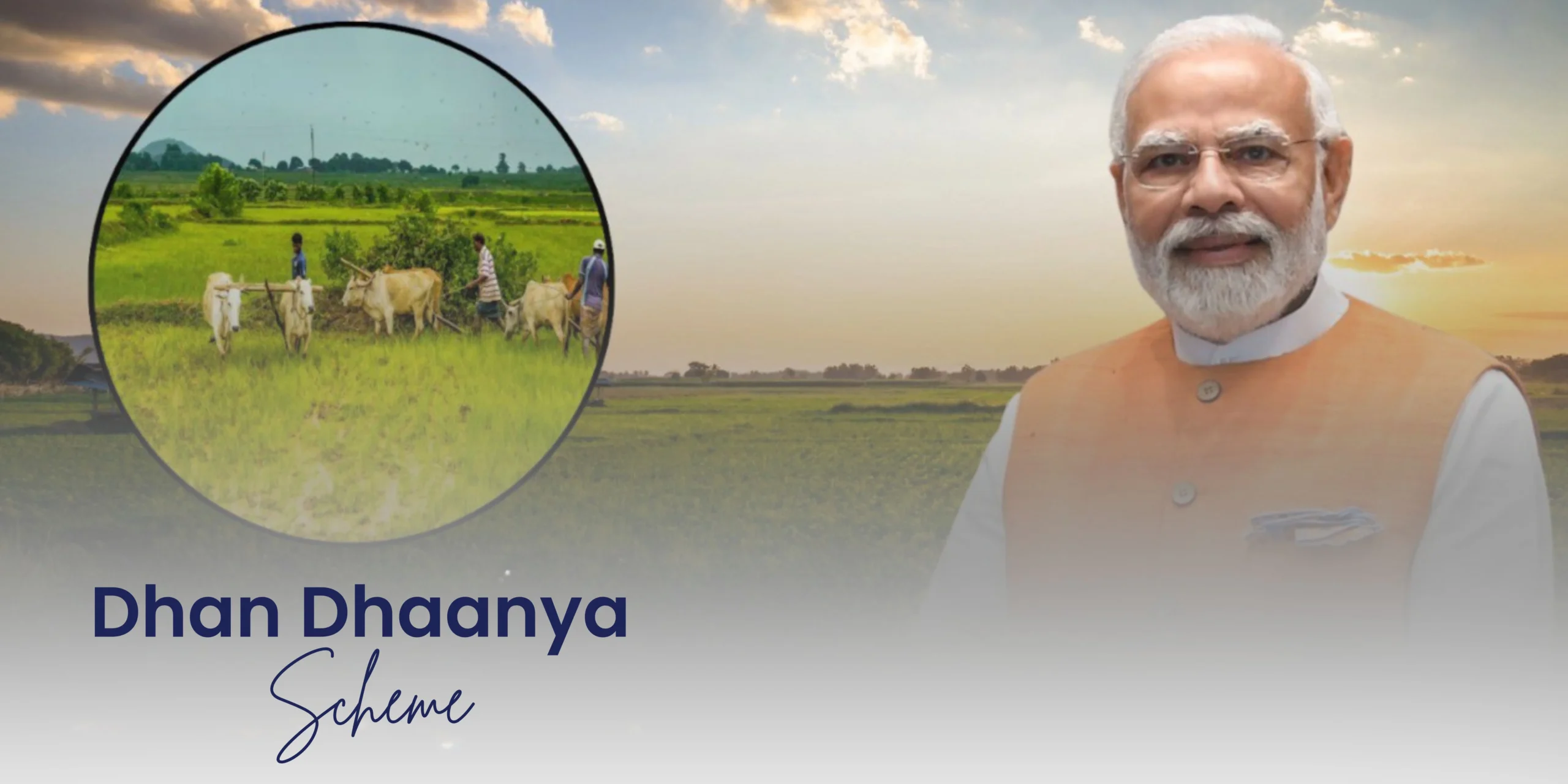
| Challenge | Description | Solution |
|---|---|---|
| Coordination | Merging 36 schemes | Central Nodal Officers |
| Awareness | Remote farmers unaware | Radio, SMS, KVK campaigns |
| Weather Risks | Droughts, floods | Resilient seeds, insurance |
| Distribution | Uneven benefits | Digital dashboard, audits |
| Infrastructure | Lack of roads, power | PPPs for facilities |
Comparison with Other Agricultural Schemes
The PMDDKY scheme is unique in combining 36 programs for a comprehensive approach, unlike individual schemes that focus on limited objectives. Here’s a comparison with other major agricultural programs:
PMDDKY vs. Other Schemes
| Scheme | Focus | Budget (2025-26) | PMDDKY Advantage |
|---|---|---|---|
| PM-KISAN | 6,000/year cash transfers to farmers | 75,000 crore | Adds irrigation, storage, markets, and training |
| PMFBY | Crop insurance against losses | 15,000 crore | Includes insurance, plus loans, technology, and infrastructure |
| PMKSY | Irrigation development (drip, sprinkler) | 11,000 crore | Covers irrigation, storage, credit, and allied sectors |
| RKVY | State-led agricultural projects | 10,500 crore | National coordination, district specific plans, and convergence |
Key Differentiators:
- Holistic Support: PMDDKY integrates cash transfers, insurance, irrigation, storage, and technology, unlike schemes with a single focus.
- District-Specific Plans: Implements customized interventions based on local needs, unlike the uniform approach of PM-KISAN.
- Technology Focus: Promotes drones, IoT, and mobile apps, which PMFBY and PMKSY do not emphasize.
- Allied Sector Inclusion: Supports dairy, fisheries, and poultry, unlike RKVY, which mainly targets crop farming.
Helpline and Official Website
As of July 25, 2025, the PMDDKY helpline and official portal are still being developed. In the meantime, farmers can access updates through existing platforms:
- Kisan Call Centre: Toll-free number 1800-180-1551 offering multilingual farmer assistance.
- PM-KISAN Helpline: Reach support at 155261 or 011-24300606 for related queries.
- Local Assistance: Farmers can visit their District Collector’s office, KVK, or Gram Panchayat for guidance.
- Official Websites: Updates and district lists will be available on pmkisan.gov.in and www.agricoop.nic.in.
The PMDDKY portal and digital dashboard, set to launch by October 2025, will offer online applications, district lists, and real-time tracking of the scheme’s 117 key performance indicators (KPIs). Farmers will be able to monitor benefits such as loan disbursements and storage facility access directly for their districts.
PMDDKY vs. State-Level Agricultural Schemes
Strengthens and aligns state-level agricultural initiatives by offering a unified national framework and supplementary resources.
- Uttar Pradesh’s UP-AGREES: Focuses on 28 districts with World Bank assistance to improve irrigation and crop productivity, backed by a ₹5,000 crore yearly budget. PMDDKY, with a broader national reach across 100 districts, expands this by adding storage facilities, credit access, women’s producer groups, and modern technologies like drones under a larger financial framework.
- Maharashtra’s SMART Project: Aims at promoting micro-irrigation and market linkages across 10,000 villages. PMDDKY builds on this model by including crop insurance, international training opportunities, and support for allied sectors such as dairy and fisheries, offering a more integrated agricultural approach.
- Bihar’s Krishi Roadmap: Prioritizes improved seed quality and technological adoption across 38 districts. PMDDKY complements it by adding provisions for storage, credit facilities, organic farming, and centralized coordination to enhance overall agricultural outcomes.
- Telangana’s Rythu Bandhu: Provides direct cash assistance of ₹10,000 per acre to farmers. PMDDKY extends beyond financial aid, focusing on infrastructure development, market linkages, and capacity-building programs for long-term agricultural sustainability.
| Scheme | State | Focus | PMDDKY Advantage |
|---|---|---|---|
| UP-AGREES | Uttar Pradesh | Irrigation, yields | Adds storage, tech, women’s groups |
| SMART | Maharashtra | Micro-irrigation, markets | Includes insurance, allied sectors |
| Krishi Roadmap | Bihar | Seeds, technology | Adds storage, credit, organic focus |
| Rythu Bandhu | Telangana | Cash transfers | Long-term infrastructure, markets |
Impact on Rural Economies
PMDDKY aims to drive holistic rural transformation, extending its impact well beyond traditional farming activities:
- Employment Generation: Creation of 10–15 jobs per village through storage units, processing plants, and allied sectors like dairy and fisheries, reducing rural unemployment.
- Income Growth: Farmers’ earnings increase by 20–40%, stimulating local economies and supporting small shops, transport, and service businesses.
- Infrastructure Development: New irrigation systems, warehouses, and processing facilities enhance agricultural productivity and rural living conditions.
- Women’s Empowerment: Women-led producer groups enable financial independence, improve family stability, and promote leadership within communities.
- Reduced Migration: Improved job opportunities and income discourage migration to cities, helping retain youth in rural areas.
- Agricultural Modernization: Use of drones, IoT tools, and digital platforms transforms villages into centers of smart, technology-driven farming.
Future Plans for PMDDKY
By 2030, scheme is set to accomplish major milestones:
- Higher Incomes: Raise farmer earnings to ₹20,000/month through better yields, diverse crops, and market access.
- Food Security: Achieve self-sufficiency in grains, pulses, and oilseeds to cut import costs.
- Sustainability: Promote organic and climate-smart farming in half of the target districts.
- Job Growth: Create 10–15 rural jobs per village in dairy, fisheries, and processing sectors.
- Smart Farming: Equip 50% of farmers with drones, IoT, and agri-apps by 2030.
- Export Boost: Increase exports of organic produce, targeting 20% of global organic trade.
Post-2030 Vision:
- District Expansion: Extend PMDDKY to more districts based on results from 2025–30.
- PPP Growth: Strengthen public-private partnerships to build more cold storage and processing facilities.
- Smart Farming: Integrate AI and IoT tools for precision farming, aiming for 75% adoption in focus districts.
- Women Empowerment: Expand women producer groups to 20,000, supporting 10 lakh women farmers.
- Agri Hubs: Establish rural hubs combining storage, processing, and markets to boost exports and local economies.
The Pradhan Mantri Dhan-Dhaanya Krishi Yojana (PMDDKY) is a major initiative to transform Indian agriculture, supporting 1.7 crore farmers across 100 districts with a ₹24,000 crore annual budget (2025–31). It offers irrigation, storage, loans, training, market access, and modern technology to empower small farmers, women, and youth. Farmers can check district inclusion after July 31, 2025, and apply by September 2025 through local offices or online portals. With its holistic approach, PMDDKY aims to make farming more profitable, sustainable, and future-ready, driving India toward self-reliant agriculture.
FAQS
In a quiet village of Seemanchal, Meena Devi, a mother of two, joined a women’s producer group under PMDDKY. She began cultivating organic vegetables and selling them directly through the digital market platform. What started as a small effort soon became a thriving business, earning her respect, income, and independence.
Now, Meena not only feeds her family but also trains other women in her community to grow and sell their produce. Her words echo the spirit of the scheme:
“PMDDKY didn’t just give us tools; it gave us courage to dream bigger.”
From Bundelkhand to Bihar, such stories remind us that true progress begins when farmers thrive, and every seed sown under this scheme carries the dream of a stronger, self-reliant India.
For official government services, please visit: www.pib.gov.in
